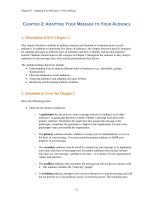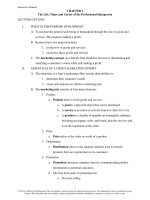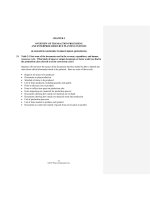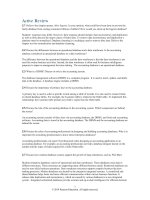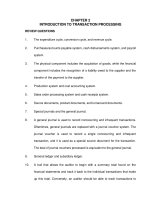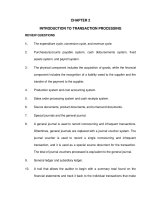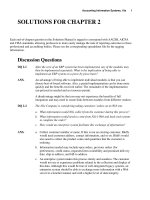Test bank and solution ch02 ethics first then customers (1)
Bạn đang xem bản rút gọn của tài liệu. Xem và tải ngay bản đầy đủ của tài liệu tại đây (460.77 KB, 59 trang )
Instructor's Manual
CHAPTER 1
The Life, Times and Career of the Professional Salesperson
LECTURE OUTLINE
I.
WHAT IS THE PURPOSE OF BUSINESS?
A. To increase the general well-being of humankind through the sale of goods and
services. This requires making a profit.
B. Business have two major functions:
1. production of goods and services
2. marketing those goods and services
C. The marketing concept says that the firm should be devoted to determining and
satisfying a customer’s wants while still making a profit.
II.
ESSENTIALS OF A FIRM’S MARKETING EFFORT
A. The essentials of a firm’s marketing effort include their abilities to:
1. determine their customer’s needs
2. create and maintain an effective marketing mix
B. The marketing mix consists of four main elements:
1. Product
a. Product refers to both goods and services
a. A good is a physical object that can be purchased
b. A service is an action or activity done for others for a fee
c. A product is a bundle of tangible and intangible attributes,
including packaging, color, and brand, plus the services and
even the reputation of the seller.
2. Price
a. Price refers to the value or worth of a product
3. Distribution
a. Distribution refers to the channel structure used to transfer
products form an organization to its customers.
4. Promotion
a. Promotion increases company sales by communicating product
information to potential customers.
b. The four basic parts of promotion are:
a. Personal selling
i
© 2013 by McGraw-Hill Education. This is proprietary material solely for authorized instructor use. Not authorized for sale or distribution in any
manner. This document may not be copied, scanned, duplicated, forwarded, distributed, or posted on a website, in whole or part.
Instructor's Manual
b. Advertising
c. Publicity
d. Sales promotion
III.
WHAT IS SELLING?
A.
Traditional definition of personal selling refers to the personal communication
of information to persuade a prospective customer to buy something—a good,
a service, an idea or something else—which satisfies that individual’s needs.
B.
Personal selling today: In early 2000’s corporate corruption contributed to the
negative image of all business professions.
1. Insurance salespeople, advertising practitioners and used car salespeople
are the lowest rated job categories in perceived honesty and ethical
standards.
2. What about you? Take Dr. Futrell’s poll (//futrell-www.tamu.edu):
a. What does the general public think about salespeople?
b. What do you think about salespeople?
c. After graduation, would you accept a sales job?
d. The main reasons for low marks may be greed and lack of
trustworthiness.
IV.
A NEW DEFINITION OF PERSONAL SELLING refers to the personal
communication of information to unselfishly persuade a prospective customer to buy
something—a good, a service, an idea or something else—which satisfies that
individual’s needs.
A.
Think of your grandmother. Would you mistreat your grandmother in a sales
transaction?
B.
V.
Salespeople should handle their customers with unselfish and ethical service.
THE GOLDEN RULE OF PERSONAL SELLING refers to the sales philosophy of
unselfishly treating others as you would like to be treated.
A.
There are different views of the Golden Rule:
1. Negative form: “If you don’t like to get cheated in a purchase, don’t
cheat others.”
2. Positive form: “If you like to receive the best price, then offer the best
price to your customers.”
ii
© 2013 by McGraw-Hill Education. This is proprietary material solely for authorized instructor use. Not authorized for sale or distribution in any
manner. This document may not be copied, scanned, duplicated, forwarded, distributed, or posted on a website, in whole or part.
Instructor's Manual
3. The Golden Rule is all about trying to keep somebody else warm even if
it means that we get cold in the process.
4. Salesperson differences can be explained by the individual’s level of
self-interest.
VI.
EVERYBODY SELLS!
A. You develop communications techniques for getting your way in life.
B. Your ability to communicate effectively is a key to success in life.
VII.
WHAT SALESPEOPLE ARE PAID TO DO
A.
Salespeople need to sell something “today” to meet performance goals for:
1. Themselves.
2. Their employer.
3. Their customers.
VIII.
WHY CHOOSE A SALES CAREER?
A.
There are six major reasons for choosing a career in sales:
1. the opportunity to provide service to others.
2. the variety of jobs available.
3. freedom of being on your own.
4. the challenge of selling.
5. the opportunity for advancement.
6. the rewards from a sales career.
iii
© 2013 by McGraw-Hill Education. This is proprietary material solely for authorized instructor use. Not authorized for sale or distribution in any
manner. This document may not be copied, scanned, duplicated, forwarded, distributed, or posted on a website, in whole or part.
Instructor's Manual
B.
Providing service means helping others.
1. A sales career provides the opportunity for service and an emotional
purpose in life gained from helping others.
a. For many, service is the number one reason for choosing a sales
career.
b. Service refers to making a contribution the welfare of others.
C.
Types of sales jobs:
1. Selling in retail - A retail salesperson sells goods or services to
consumers for their personal, non-business use.
a. Three common types of retail sellers:
(1) in-store salespersons.
(2) direct sellers who sell face-to-face away from a fixed location.
(3) telephone salespersons.
2. Selling for a wholesaler - Wholesalers buy products from manufacturers
and other wholesalers and sell to other organizations.
a. A wholesaler salesperson sells products to parties for:
(1) Resale.
(2) Use in producing other goods or services.
(3) Operating an organization.
b. Firms engaged in wholesaling are called wholesaling middlemen.
They vary greatly in:
(1) The products they sell.
(2) The markets to which they sell.
(3) Their methods of operation.
3. Types of manufacturer’s sales representatives:
a. Account representatives - call on a large number of already
established customers.
b. A detail salesperson - concentrates on performing promotional
activities and introducing new products rather than directly
soliciting orders.
c. A sales engineer - sells products that call for technical know-how.
d. An industrial products salesperson (non-technical) sells tangible
products to industrial buyers.
iv
© 2013 by McGraw-Hill Education. This is proprietary material solely for authorized instructor use. Not authorized for sale or distribution in any
manner. This document may not be copied, scanned, duplicated, forwarded, distributed, or posted on a website, in whole or part.
Instructor's Manual
e. A service salesperson - sells intangible products such as financial
services, advertising, or computer repair services.
f. An order-getter - gets new and repeat business using creative sales
strategy and a well-executed sales presentation.
(1) An order-getter has two selling challenges:
(a) Must often create discontent with what the prospect already
has before beginning to sell constructively.
(b) Often has to overcome the most powerful and obstinate
resistance.
g. An order-taker - asks what the customer wants or waits for the
customer to order.
D.
Freedom of Action - You’re on your own with very little direct supervision.
E.
The Job Challenge is always there which means great responsibility.
F.
Opportunities for advancement are great.
1. Some companies promote salespeople to managerial positions very
quickly. For most companies the path to a sales management position
begins with an entry level position.
a. A sales personnel career path.
(1) Junior or trainee level.
(a) Learn the attitudes and activities of the company’s
salespeople.
(b) Become familiar with customer’s attitudes toward the
company, its products, and its salespeople.
(c) Gain first-hand knowledge of products and their
application.
(d) Become seasoned in the world of business.
(2) Regular sales position.
(3) Senior sales positions or key account sales positions contact
larger, more important customers.
2. There are two career paths:
a. Permanent salespeople.
b. Management.
G.
Rewards - The sky’s the limit!
v
© 2013 by McGraw-Hill Education. This is proprietary material solely for authorized instructor use. Not authorized for sale or distribution in any
manner. This document may not be copied, scanned, duplicated, forwarded, distributed, or posted on a website, in whole or part.
Instructor's Manual
1. Two types of rewards:
a. Non-financial (i.e. psychological income or intrinsic rewards).
(1) Feeling of self-worth and accomplishment.
(2) Realization that the job is important.
b. Financial:
(1) The opportunity to earn large salaries.
(2) Rewarded on basis of performance.
(3) Comparatively large beginning salaries.
(4) Overall, salaries for field sales personnel have been moving
rapidly upward.
H.
You can move quickly into management.
1. District sales manager.
a. First managerial level.
b. Promotion usually occurs within the first three years.
2. Compensation of sales managers.
a. A beginning sales job is the stepping stone to higher positions and
higher salaries.
b. Both corporate and field sales managers receive higher salaries
than others at the same organizational level.
vi
© 2013 by McGraw-Hill Education. This is proprietary material solely for authorized instructor use. Not authorized for sale or distribution in any
manner. This document may not be copied, scanned, duplicated, forwarded, distributed, or posted on a website, in whole or part.
Instructor's Manual
IX.
IS A SALES CAREER RIGHT FOR YOU?
A.
Seven questions to ask yourself:
1. What are my past accomplishments?
2. What are my future goals?
3. Do I want to have the responsibility of a sales job?
4. Do I mind travel? How much travel is acceptable?
5. How much freedom do I want in the job?
6. Do I have the personality characteristics for the job?
7. Am I willing to transfer to another city? Another state?
B.
Once you have answered these questions, you should:
1. Determine the industries, types of products and services, and specific
companies in which you have an interest.
2. Talk to people presently or formerly involved in sales.
C.
A Sales Manager’s view of the recruit.
1. What are the applicants judged on?
a. Appearance
b. Self-expression
c. Maturity
d. Personality
e. Experience
f. Enthusiasm
g. Interest in the job
X.
SUCCESS IN SELLING-WHAT DOES IT TAKE?
A.
Think of success spelled with four s’s as in “ssuccess”.
1. S - Success begins with love.
a. The successful salesperson is an individual who loves selling.
b. Of the eight, love is the number one characteristic of successful
salespeople.
2. S - Service to others - Salespeople love to help others fulfill their needs
through selling their products.
3. U - Use the Golden Rule of Selling.
a. Today’s salesperson needs to treat others as he would like to be
treated.
vii
© 2013 by McGraw-Hill Education. This is proprietary material solely for authorized instructor use. Not authorized for sale or distribution in any
manner. This document may not be copied, scanned, duplicated, forwarded, distributed, or posted on a website, in whole or part.
Instructor's Manual
b. People like to buy, not be sold.
4. C - Communication ability.
a. Good salespeople are good communicators. Great salespeople are
great communicators.
b. Top salespeople speak the other person’s language.
5. C - Characteristics for the Job - It helps if you possess the personal
characteristics needed for a sales career.
6. E - Excels at strategic thinking.
a. High performing salespeople tend to be strategic problem solvers
for their customers.
b. Match up products benefits with customer’s needs.
7. S - Sales knowledge at the M.D. level.
a. Top salespeople have mastered the basic competencies of product
knowledge and selling skills.
b. As goods and services become more complex, companies place
more emphasis on the training of salespeople.
c. Knowledge is power, but enthusiasm pulls the switch.
8. S - Stamina for the challenge.
a. Today’s salesperson needs to be physically, mentally and
spiritually prepared to meet the daily challenges of a sales career.
b. The increased feeling of well-being gained from exercise transmits
itself to the body and mind.
c. People’s faith may direct everything they do on the job, ranging
from how customers are treated to how ethical they act toward
their employer.
XI.
C — CHARACTERISTICS FOR THE JOB EXAMINED. A salesperson can choose
to be like the traditional salesperson we all do not care for, or he or she can be like the
salesperson who is truly people oriented.
A.
Caring, Joy and Harmony. Through caring comes the joy of helping others.
B.
Patience, Kindness and Morally Ethical.
1. Let the customer decide when to buy instead of pressuring for a quick
decision.
viii
© 2013 by McGraw-Hill Education. This is proprietary material solely for authorized instructor use. Not authorized for sale or distribution in any
manner. This document may not be copied, scanned, duplicated, forwarded, distributed, or posted on a website, in whole or part.
Instructor's Manual
2. By showing that customers come first, salespeople are more likely to
gain the trust of the customer.
C.
Faithful, Fair, and Self-Controlled.
1. The salesperson will spend the time necessary to help, not just to make
the sale and never be heard from again.
2. Self-control should be exhibited in closing a sale - Is consideration only
given to the salesperson’s needs and thus pressure placed on the
customer to buy something not needed?
3. Self-control involves discipline.
a. Often the biggest challenge to success is not out there in the sales
territory, it’s within us.
b. Discipline yourself to set priorities in your life - What comes first,
your job or your family?
XII.
RELATIONSHIP SELLING.
A. The salesperson of today is a pro.
1. Relationship selling - the process of professionally providing
information for helping customers make intelligent actions to achieve
their short- and long-term objectives.
2. Four main elements (ABC’s) in the customer relationship process used
by salespeople to build relationships are:
a. Analyze customer needs.
b. Present product Benefits.
c. Gain Commitment for the purchase.
d. Provide excellent Service in order to maintain and grow the
relationship.
B. Sales jobs are different from other jobs in several ways.
1. Since salespeople represent their company, opinions of a company and
its products are often based on the salespeople.
2. The outside salesperson typically operates with little direct supervision
and needs a high degree of motivation.
3. Salespeople probably need more tact, diplomacy, and social poise.
4. Salespeople are authorized to spend company funds on entertainment,
transportation, and other business expenses.
ix
© 2013 by McGraw-Hill Education. This is proprietary material solely for authorized instructor use. Not authorized for sale or distribution in any
manner. This document may not be copied, scanned, duplicated, forwarded, distributed, or posted on a website, in whole or part.
Instructor's Manual
5. Selling requires mental toughness and physical stamina.
XIII.
WHAT DOES A PROFESSIONAL SALESPERSON DO?
A. A Territory Manager plans, organizes, and executes activities that increase the
sales and profits in his territory (i.e. a group of customers assigned to him in a
geographical area).
B. A territorial manager performs nine functions:
1. Creates new customers.
a. Locate people and/or organizations that have the potential to buy
their products
b. Needs the ability to close the sale.
2. Sells more to current customers.
3. Builds long-term relationships with customers - Earning the opportunity
to sell a present customer more product means the salesperson must have
a professional relationship with people and organizations.
4. Provides solutions to customers’ problems - Shows how these problems
can be solved through the purchase of his company’s products and
services.
5. Provides service to customers such as:
a. Handling complaints.
b. Returning damaged merchandise.
c. Providing samples.
d. Suggesting business opportunities.
e. Recommending promotional techniques.
f. Working at the customer’s business.
g. In-store demonstrations.
h. Accompany distributor’s salespeople on sales calls.
6. Helps customers resell products to their customers.
a. Contacts both wholesale customers (distributors) and their retail
customers.
b. Develops promotional programs for retail customers such as:
(1) Advertising materials.
(2) Store demonstrations.
(3) Setting up product displays.
x
© 2013 by McGraw-Hill Education. This is proprietary material solely for authorized instructor use. Not authorized for sale or distribution in any
manner. This document may not be copied, scanned, duplicated, forwarded, distributed, or posted on a website, in whole or part.
Instructor's Manual
7. Helps customers use products after purchase - Help the customer obtain
full benefit from the product.
8. Builds goodwill with customers - Develops a personal, friendly, business
relationship with anyone who may influence a buying decision.
9. Provides company with market information such as:
a. Competitor’s activities.
b. Customers’ reactions to new products.
c. Complaints about products and policies.
d. Market opportunities.
e. His own job activities.
XI.
REFLECT BACK
A. Review these nine functions to see what they mean and if you could do any or all
of them. Carefully think about the second and third functions. To be successful, a
salesperson must close sales and build relationships with the same person and/or
organization in order to see more business. When combined and properly
implemented, these nine job activities produce increased sales for the organization
and more rewards for the salesperson.
XII.
THE FUTURE FOR SALESPEOPLE.
A. Learning selling skills.
1. Both an art and a science.
a. Requires practice.
b. Requires training.
2. Conceptual skills - ability to see selling process as a whole and
relationships among its parts.
3. Human skills - ability to work with and through others.
4. Technical skills - understanding and being proficient at specific tasks.
B. Preparing for the 21st Century - Changes are occurring which will require
salespeople to be knowledgeable in new areas such as:
1. International dealings.
2. Sales force’s reflecting customer diversity.
3. Customer partnering to keep current customers.
4. Success based on customer satisfaction.
5. Increasing use of technology (e-selling).
xi
© 2013 by McGraw-Hill Education. This is proprietary material solely for authorized instructor use. Not authorized for sale or distribution in any
manner. This document may not be copied, scanned, duplicated, forwarded, distributed, or posted on a website, in whole or part.
Instructor's Manual
XIII.
E-SELLING: TECHNOLOGY AND INFORMATION BUILD RESATIONSHIPS
A. The information and knowledge needed for the salesperson to properly sell and
service perhaps several hundred customers has expanded well beyond what any
individual could possibly know.
B. The good news is that technology has exploded the boundaries of today’s
knowledge frontiers. Technology is making it possible to improve a person’s sales
and service performance.
xii
© 2013 by McGraw-Hill Education. This is proprietary material solely for authorized instructor use. Not authorized for sale or distribution in any
manner. This document may not be copied, scanned, duplicated, forwarded, distributed, or posted on a website, in whole or part.
Instructor's Manual
XIV. SELLING IS FOR LARGE AND SMALL ORGANIZATIONS
A. Many textbooks examples are from big business because readers typically
recognize America’s large organizations, which are important to our prosperity.
B. Small business also contributes significantly to our economy and because most
large firms started small, and then prospered by using many of the concepts
discussed in this textbook, we use small business as examples throughout this
textbook.
XV.
THE PLAN OF YOUR TEXTBOOK.
A. This book will provide the student with the fundamentals of what Selling is all
about.
B. Major topics include:
1. The role of the sales force in the firm’s marketing efforts.
2. The social, ethical, and legal issues in selling.
3. Why people and organizations buy what they do.
4. Verbal and non-verbal communications.
5. The importance of knowing your own, and your competitor’s products.
6. An in-depth discussion of the selling process.
7. Self, time, and sales territory management.
XVI. BUILDING RELATIONSHIPS THROUGH THE SALES PROCESS
A. The sales process refers to a logical, sequential series of actions that can greatly
increase the chances of making a sale.
B. Ten steps in the selling process:
1. Prospecting
2. Preapproach
3. Approach
4. Presentation
5. Trial Close
6. Objections
7. Meet Objections
8. Trial Close
9. Close
10. Follow-up
xiii
© 2013 by McGraw-Hill Education. This is proprietary material solely for authorized instructor use. Not authorized for sale or distribution in any
manner. This document may not be copied, scanned, duplicated, forwarded, distributed, or posted on a website, in whole or part.
Instructor's Manual
C. A basic sales presentation is shown in the chapter ending Exhibit and written
materials.
1. This section is too detailed to describe here. The PPT does a great job of
taking students through the sales presentation.
xiv
© 2013 by McGraw-Hill Education. This is proprietary material solely for authorized instructor use. Not authorized for sale or distribution in any
manner. This document may not be copied, scanned, duplicated, forwarded, distributed, or posted on a website, in whole or part.
Instructor's Manual
CHAPTER I APPENDIX
The Golden Rule of Personal Selling as Told by a Salesperson
I.
THE GOLDEN RULE OF SELLING
A. Base your sales philosophy on unselfishly treating others as you would like to be
treated.
II.
OTHERS INCLUDE COMPETITORS
A. The Golden Rule of Selling especially applies to your relationship with
competitors.
B. If your products do not fulfill a customer’s needs, then possibly suggest or discuss
a competitor’s product.
III.
SALES IS YOUR CALLING TO SERVE
A. Your occupation is not work – it’s what you do. It defines who you are.
B. Serving others provides you with an emotional purpose in life.
IV.
TO SERVE YOU NEED KNOWLEDGE
A. Being knowledgeable on products and selling skills allows you to provide a high
level of customer service.
V.
CUSTOMERS NOTICE INTEGRITY
A. Your customers trust that you are looking out for their best interest because you
are a person of integrity.
B. To you, integrity is who you are when no one is looking.
VI.
PERSONAL GAIN IS NOT YOUR GOAL
A. You are never concerned about sales goals, only customers.
VII.
OTHERS COME FIRST
A. Build up a reputation as a volunteer in your community.
VIII.
THE GOLDEN RULE IS NOT
A. Corruptible It Is Not
1. It is composed of pure gold. There are no impurities in it.
B. Self-Serving It Is Not
1. There is no reciprocity involved in applying the Golden Rule to anything.
C. Comprehensive It Is Not
1. There is more involved in being a good person. It will not solve every problem.
D. Easy To Follow It Is Not
IX.
THE GREAT HARVEST LAW OF SALES
xv
© 2013 by McGraw-Hill Education. This is proprietary material solely for authorized instructor use. Not authorized for sale or distribution in any
manner. This document may not be copied, scanned, duplicated, forwarded, distributed, or posted on a website, in whole or part.
Instructor's Manual
A. How you treat others will often determine how you will be treated.
B. Small acts of kindness towards someone over time often results in returns greater
than were sown.
C. Golden Rule Paradox
1. By placing customers first, you often will see increases in sales, greater
compensation, and better job opportunities.
2. You actually receive more than given to the customer or employer.
X.
THE COMMON DENOMINATOR OF SALES SUCCESS
A. The common denominator (trait) of successful salespeople
1. Unselfishly and sacrificially “caring” for prospects, and others, by placing their
interests before our desires.
XI.
THE FRUITS OF THE SELLING SPIRIT
A. Applying the Golden Rule to work and life results in a fruitful life.
xvi
© 2013 by McGraw-Hill Education. This is proprietary material solely for authorized instructor use. Not authorized for sale or distribution in any
manner. This document may not be copied, scanned, duplicated, forwarded, distributed, or posted on a website, in whole or part.
Instructor's Manual
CHAPTER 2
Ethics First … Then Customer Relationships
LECTURE OUTLINE
1. WHAT INFLUENCES ETHICAL BEHAVIOR?
A.
The individual’s role:
1. People behave differently because of their:
a. Worldviews - people's different beliefs about the world around
them.
b. Morals - people's adherence to right or wrong behavior and right or
wrong thinking.
2. Individuals usually can be placed into one of three levels of moral
development:
a. Pre-conventional — an individual acts in one’s own best interests,
and thus follows rules to avoid punishment to receive rewards.
Will break moral and legal laws. “What can I get away with?”
b. Conventional — individual conforms to expectations of others.
Upholds moral and legal laws. “What am I legally required to do?”
c. Principled — an individual lives by an internal set of morals,
values and ethics. These are upheld regardless of punishments or
majority opinion. “What is the right thing to do?”
B.
The organization’s role is often characterized by pre-conventional or
conventional levels of moral behavior.
XII.
ARE THERE ANY ETHICAL GUIDELINES?
A.
What does the research say?
1. American adults said by a 3-to-1 margin that truth is always relative to a
person’s situation.
2. People are most likely to make their moral and ethical decisions on the
basis of whatever feels right or comfortable in a situation.
B.
What does one do?
1. What would you do if you found a bank bag with $125,000? Would you
return it to the bank?
2. What would you do if you found a wallet? Why might you be more
likely to return the wallet without taking any of the money?
xvii
© 2013 by McGraw-Hill Education. This is proprietary material solely for authorized instructor use. Not authorized for sale or distribution in any
manner. This document may not be copied, scanned, duplicated, forwarded, distributed, or posted on a website, in whole or part.
Instructor's Manual
3. Out of class, is it alright to copy someone’s homework assignment even
when the course syllabus states that you have to do your own work?
What keeps you from copying on an exam when your professor is out of
the room?
4. Is it okay to offer a customer a $10,000 trip if they place a $3 million
order? Why would you not even question paying for a $20 lunch
associated with the same purchase?
C.
Is your conscience reliable?
1. We all have an internal ultimate moral standard that we use to measure
good and evil, right and wrong.
2. Most of us know not to keep the $125,000 or the wallet or copy someone
else’s work, but what would we actually do?
3. If a person’s value system is at the level 2 stage of development, this
person makes decisions based upon the “situation” and what others say
and do.
a. Usually people rationalize their actions, such as, “I will only copy
the homework this one time.”
4. Many people are so accustomed to doing things unethically that they
think nothing about it.
D.
Sources of significant influence.
1. Do your decision factors include your friends, family or things you see
on television or in the movies? Do their thoughts on what is ethical
sometimes change from day to day?
2. Basic research by Barna has found that the leading influencers in
American society are movies, television, the Internet, books, music,
public policy and law, and family.
3. Wouldn’t it be nice to be able to base your decisions on something that
never changes?
4. The situations businesspeople face are frequently the same, yet many
ethical decisions are unique to the situation.
E.
Three guidelines for making ethical decisions.
1. You need a fixed point of reference that is separate from you so that you
and no one else may influence it.
xviii
© 2013 by McGraw-Hill Education. This is proprietary material solely for authorized instructor use. Not authorized for sale or distribution in any
manner. This document may not be copied, scanned, duplicated, forwarded, distributed, or posted on a website, in whole or part.
Instructor's Manual
a. Fixed point of reference — refers to something that provides the
correct action to take in any situation and never gets “tailored” to
fit an occasion.
b. Separate from you — refers to something outside yourself that may
be used for reference.
c. No one else may influence it — refers to something that is
unchangeable by you or anyone else. For example, navigators use
stars for navigation — the stars are fixed points in the sky that are
separate from you and no one can change them.
d. How does this relate to a person making ethical and moral
decisions in life?
F.
Will the Golden Rule Help?
1. One similarity in virtually all faith-based principles is the presence of a
“Golden Rule” concept.
2. The Golden Rule does not involve reciprocity—“if you do for me, I will
do for you.” It is doing for others without expecting something in return.
3. “Could the Golden Rule serve as a universal, practical, helpful standard
for the businessperson’s conduct?”
4. President Bush thinks so. He said, “A call to love your neighbor just
like you’d like to be loved yourself. It’s a universal call, and it’s a call
that has been applicable throughout history. It’s really needed right
now.”
5. Would you consider your faith a fixed point of reference that never
changes and is separate from you?
XIII.
MANAGEMENT’S ETHICAL RESPONSIBILITIES
A.
Ethics — Code of moral principles and values that govern the behaviors of a
person or group with respect to what is right or wrong.
B.
Ethical Behavior — treating others fairly.
1. Being Honest.
2. Maintaining confidence and trust.
3. Following the rules.
4. Conducting yourself in the proper manner.
5. Treating others fairly.
xix
© 2013 by McGraw-Hill Education. This is proprietary material solely for authorized instructor use. Not authorized for sale or distribution in any
manner. This document may not be copied, scanned, duplicated, forwarded, distributed, or posted on a website, in whole or part.
Instructor's Manual
6. Demonstrating loyalty to company and responsibility.
7. Carrying your share of work and responsibility.
C.
An Ethical Dilemma is a situation when each alternative choice or behavior
has some undesirable elements due to potentially negative ethical or personal
consequences.
XIV. ETHICS IN DEALING WITH SALESPEOPLE
A.
Sales Managers have both social and ethical responsibilities to their sales
personnel.
B.
Five ethical considerations by sales managers are:
1. Level of sales pressure to place on a salesperson.
2. Decisions affecting territory.
3. Whether or not to be honest with the salesperson.
4. What to do with the salesperson who is ill.
5. What rights do employees have?
a. Termination-at-will — must now have accurate records which led
to an employee’s termination.
b. Privacy — non-job related information is being taken out of
personal files by employers.
c. Cooperative acceptance — employees are protected by law from
acts of discrimination and sexual harassment.
C.
Company benefits of respecting employee rights:
1. Employees are more productive.
2. It attracts good sales personnel.
3. It reduces legal costs.
4. It reduces wage-increase demands.
XV.
SALESPEOPLE’S ETHICS IN DEALING WITH THEIR EMPLOYERS - salespeople,
as well as managers, may occasionally:
A.
Misuse company assets – for personal gain or as bribes to customers.
B.
Moonlight – take a second job or college course on company time.
C.
Cheat – not play fair in contests.
D.
Affect other salespeople – the unethical practices of one salesperson can affect
other salespeople within the company.
xx
© 2013 by McGraw-Hill Education. This is proprietary material solely for authorized instructor use. Not authorized for sale or distribution in any
manner. This document may not be copied, scanned, duplicated, forwarded, distributed, or posted on a website, in whole or part.
Instructor's Manual
E.
Attempt technology theft – take customer records, after quitting or being fired
for his or her or a future employer’s benefit.
XVI. ETHICS IN DEALING WITH OTHER CUSTOMERS
A.
Common problems faced in dealing with customers:
1. Bribes - There is a thin line between good business and the misuse of a
bribe or gift.
2. Misrepresentation — of the product, company, company policies, prices,
or delivery time in attempt to make a sale.
a. Salespeople must understand the difference between opinions and
statements of fact.
(1) Opinions do not have legal consequences.
(2) A company may be sued if its salesperson uses erroneous
statements of “fact.”
b. Suggestions for staying legal:
(1) Understand the difference between statements of praise and
statements of fact.
(2) Educate customers.
(3) Be accurate.
(4) Know the product’s technical specifications.
(5) Avoid exaggerations about product safety.
(6) Be familiar with laws regarding warranties.
(7) Understand your product’s capabilities.
(8) Keep current with design changes.
(9) Avoid offering untested opinions.
(10) Never overstep authority.
3. Price discrimination - Some customers may be given price reductions,
promotional allowances and support while others are not. Violation of
the Robinson-Patman Act of 1936.
4. Tie-in-sales - When the buyer is required to buy other products that are
not wanted. Prohibited under the Clayton Act.
5. Exclusive Dealership - also prohibited under the Clayton Act.
6. Reciprocity - buying a product from someone if the person or
organization agrees to buy from you.
xxi
© 2013 by McGraw-Hill Education. This is proprietary material solely for authorized instructor use. Not authorized for sale or distribution in any
manner. This document may not be copied, scanned, duplicated, forwarded, distributed, or posted on a website, in whole or part.
Instructor's Manual
7. Sales restrictions.
a. FTC “cooling off” laws.
(1) Within three days, buyer can:
(a) Cancel contract.
(b) Return merchandise.
(c) Obtain full refund.
(2) Law covers sales of $25 or over made door-to-door.
(3) Buyer must have written, dated contract and be told of the
three-day period.
b. Green River Ordinance — required a license for selling direct to
consumers.
XVII. THE INTERNATIONAL SIDE OF ETHICS - Despite different laws in other countries,
U.S. firms are subject to U.S. laws internationally.
XVIII. MANAGING SALES ETHICS
A.
Follow the leader - chief executives may set the example.
B.
Leader selection - carefully choose managers with high levels of moral
development.
C.
Establish a Code of Ethics - a formal statement of the company’s views
concerning ethics and social values which includes:
1. Principle-based statements.
2. Policy-based statements.
D.
Create Ethical Structures such as an:
1. Ethical Committee - group of executives appointed to oversee company
ethics.
2. Ethical ombudsman - official given the responsibility of corporate
conscience that hears and investigates ethical complaints and informs
top management of potential ethical issues.
E.
Encourage whistle-blowing.
F.
Create an ethical sales climate.
G.
Establish control systems.
XIX. HELPFUL HINTS TO MAKING CAREER DECISIONS
A.
Be involved in businesses/organizations that make worthwhile products.
B.
Do what is right according to your beliefs no matter what the costs.
xxii
© 2013 by McGraw-Hill Education. This is proprietary material solely for authorized instructor use. Not authorized for sale or distribution in any
manner. This document may not be copied, scanned, duplicated, forwarded, distributed, or posted on a website, in whole or part.
Instructor's Manual
XX.
C.
Do not compromise your beliefs.
D.
Put people first.
E.
Recognize the importance of good people.
DO YOUR RESEARCH - In a potential employer look for:
A.
Integrity - The business should be honest without compromise or corruption.
B.
Trust - You have to know you can trust your employer.
C.
Character - What is the company like when no one is looking, and what do
they stand for?
D.
Values - The company should follow a moral code of conduct toward otherslike the Golden Rule!
E.
Truth - The company should be true to their word and reflect the best of
mankind.
F.
Love - The company should display a strong affection, desire, or devotion
toward people (the CCC GOMES). Love should be the business's
cornerstone.
XXI. GOLDEN RULE OF SELLING
A. What is truth?
1. Facts needed to make ethical and moral decisions
2. But what are true facts? (What a discussion you can have here!)
XXII. SUMMARY OF MAJOR ISSUES
A.
Ethical behavior pertains to values of right and wrong.
B.
Values depend on individual and organizational characteristics.
1. An important individual characteristic is one's moral development.
2. Corporate culture is an organizational characteristic.
C.
Corporate social responsibility is based on four criteria:
1. Economic responsibility.
2. Legal responsibility.
3. Discretionary responsibility
D.
Social responsibility in business means profitably serving employees and
customers in an ethical and lawful manner regardless of cost.
E.
Could the Golden Rule serve as a universal, practical, helpful standard for
people's conduct?
xxiii
© 2013 by McGraw-Hill Education. This is proprietary material solely for authorized instructor use. Not authorized for sale or distribution in any
manner. This document may not be copied, scanned, duplicated, forwarded, distributed, or posted on a website, in whole or part.
Instructor's Manual
F.
In the future, ethical standards for salespeople must be developed, supported,
and policed. Current techniques include:
1. Leadership
2. Codes of Ethics
3. Ethical Structures
4. Whistle-blowing
5. Establishing Control Systems
D.
Socially responsible organizations perform as well as - and often better than organizations that are not socially responsible.
xxiv
© 2013 by McGraw-Hill Education. This is proprietary material solely for authorized instructor use. Not authorized for sale or distribution in any
manner. This document may not be copied, scanned, duplicated, forwarded, distributed, or posted on a website, in whole or part.
Instructor's Manual
CONTENTS
Part I: Course Organization and Teaching Methods
To the Instructor ..................................................................................................................................... 3
Student Application Learning Exercises (SALES) ............................................................................... 4
What
Professor
Futrell
Does
Now……………………………………………………………………….4
Example of a Class Syllabus ................................................................................................................ 22
Example of a Tentative Schedule ......................................................................................................... 31
Student Information Sheet .................................................................................................................... 35
Sales Presentation Guidelines............................................................................................................... 38
Shadow Project ..................................................................................................................................... 41
Marketing 335 Sales Challenge ............................................................................................................ 43
Sales Diary ........................................................................................................................................... 44
Role-Playing: An Overview ................................................................................................................. 46
Instructions to Each Buyer ................................................................................................................... 47
Develop Your Own Videotape Examples ............................................................................................ 48
Futrell’s Pro Selling Video ................................................................................................................... 48
Alternative Role-Play Assignments ..................................................................................................... 50
Part II: Videos Accompanying ABC's of Relationship Selling: Outlines and Test Questions ........... 53
Part III: Lecture Notes
Chapter outlines available for printing or downloading at Web site: . Go to Professor Futrell Online! Then click on Classes, Marketing 335, ABC's of
Relationship Selling's book cover, and then Chapter Outlines. Using www.mays.tamu.edu, first go
Note:
to Marketing Department, Faculty, Professor Charles M. Futrell, Classes, etc.
I. Selling as a Profession
Chapter 1
Chapter 2
The Life, Times, and Career of the Professional Salesperson ....................... 77
Ethics First … Then Customer Relationships ............................................... 93
II. Preparation for Relationship Selling
Chapter 3
Chapter 4
Chapter 5
The Psychology of Selling: Why People Buy ............................................. 102
Communication for Relationship Building: It's Not All Talk ..................... 109
Sales Knowledge: Customers, Products, Technologies .............................. 117
III. The Relationship Selling Process
Chapter 6
Prospecting—The Lifeblood of Selling ...................................................... 125
Chapter 7
Planning
the
Sales
Call
is
a
Must!…………….……………………………..…131
Chapter 8
Carefully Select Which Sales Presentation Method to Use......................... 135
Chapter 9
Begin Your Presentation Strategically ........................................................ 141
Chapter 10
Elements of a Great Sales Presentation ....................................................... 145
Chapter 11
Welcome Your Prospects Objections .......................................................... 151
Chapter 12
Closing Begins the Relationship ................................................................. 158
Chapter 13
Service and Follow-up for Customer Retention .......................................... 164
xxv
© 2013 by McGraw-Hill Education. This is proprietary material solely for authorized instructor use. Not authorized for sale or distribution in any
manner. This document may not be copied, scanned, duplicated, forwarded, distributed, or posted on a website, in whole or part.
